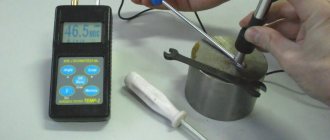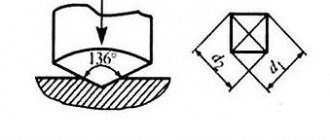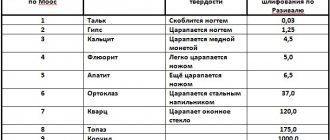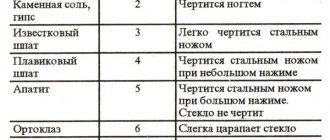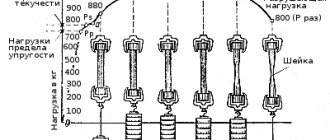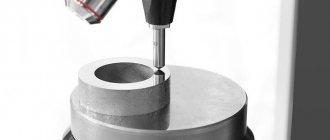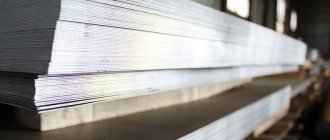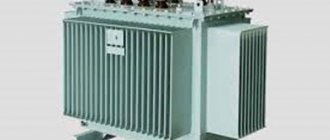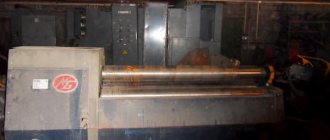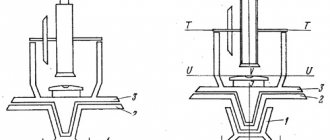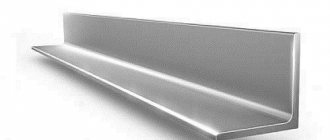Test details
A typical test uses a 10 mm (0.39 in) diameter steel ball as an indenter with 3000 kgf (29.42; 6.614 lbf) force. For softer materials, less force is used; For harder materials, the tungsten carbide ball is replaced with a steel ball. The dent is measured and the hardness is calculated as:
BHN = 2 p π D ( D − D 2 − d 2 ) { displaystyle operatorname {BHN} = { frac {2P} { pi D left (D — { sqrt {D^{2}-d^{2))} right)}}}
Where:
BHN = Brinell hardness number (kgf/mm2)
n
= applied load in kilogram-force (kgf)
D
= indenter diameter (mm)
d
= indentation diameter (mm)
Brinell hardness is sometimes expressed in megapascals; The Brinell hardness number is multiplied by the acceleration due to gravity, 9.80665 m/s.2, to convert it to megapascals.
BHN can be converted to ultimate tensile strength (UTS), although the relationship is material dependent and therefore determined empirically. The relationship is based on the Meyer index (n) from Meyer's Law. If the Meyer index is less than 2.2, then the UTS to BHN ratio is 0.36. If the Meyer index is greater than 2.2, then the coefficient increases.[1]
BHN
designated by the most commonly used test standards (ASTM E10-14[2] and ISO 6506–1:2005[3]) as
HBW
(
H
of Hardness,
B
of Brinell, and
W
of tungsten carbide (tungsten) indenter material). In previous standards, HB or HBS were used to refer to measurements made with steel indenters.
HBW is calculated in both standards using SI units as
HBW = 0.102 2 F π D ( D − D 2 − d 2 ) { displaystyle operatorname {HBW} = 0.102 { frac {2F} { pi D left (D — { sqrt {D^{2} -d^{2} }} right)}}}
where:
F
= applied load (newtons)
D
= indenter diameter (mm)
d
= indentation diameter (mm)
Hardness of materials and methods for measuring it
Hardness is the ability of a body to undergo plastic deformation under the influence of an even harder tool called an indenter.
There are several popular methods for testing materials, and especially metals, for hardness. Using them, you can obtain both a certain numerical equivalent of the strength of the product and data on its resistance to alternating loads.
The main determination methods include:
- 1. Brinell method (instruments and the process itself will be described in detail below). When using it, hardness is determined using the imprint of a hard, most often metal ball, pressed into a flat area of the part. Hardness is judged by the diameters of the marks.
Fig.1 Appearance of a modern hardness tester.
- 2. Rockwell method. According to it, the hardness value is equal to the relative depth of indentation of a similar ball or diamond cone, used according to Brinell, into a pad on the surface of the part being studied and is most often indicated by the symbols HR. Because the value is relative, then the maximum Rockwell hardness value is HR=100. Rockwell is widely used in assessing the quality of working units of equipment for processing plastics and elastomers, as well as technological equipment.
- 3. Vickers method. It is similar to the Brinell method, but when it is used, a tetrahedral diamond pyramid is used and, accordingly, the trace left by it. The numerical value of hardness (denoted as HV) in this case is equal to the ratio of the load applied to the pyramid to the area of the trace from it.
- 4. Shore hardness (indentation method, designated Shore A, Shore D). It is essential for determining the hardness of plastics, elastomers and composites. According to it, the hardness of the material is equal to the depth of penetration of a specially prepared steel needle into it, which is brought into tension by a calibrated spring. A device that works according to the Shore method is a durometer. Regulated by the international standard ASTM D2240, the process includes the use of 12 scales, but in practice the vast majority of softer materials (for example, rubbers and elastomers are tested on the A scale), and harder ones (plastics and composites) on the D scale.
- 5. Durometers and scales Asker is another method related to Shore’s developments, similar in measurement method to the previous one. It is used to obtain values for soft substances, is used mainly in Japan and has minor differences from Shore, for example in the features of equipment, scales and indenters.
- 6. Shore hardness (rebound method). Used to obtain hardness values for very hard parts, such as metal. The value of the indicator (designated HSx) is determined by the rebound height of a special striker, which falls from a standard height.
- In addition to the basic methods described, there is also a set of rarer techniques, for example, the Kuznetsov-Herbert-Rebinder method, the Poldi or double ball imprint technique, determinations on the Mohs scale, the Buchholz method, etc. In this article we will not consider them in more detail and ask you to refer to specialized literature.
Shared values
When quoting the Brinell hardness number (BHN or more commonly HB), the test conditions used to obtain the number must be specified. (HB is not related to the grade of "HB" hardness of the pencil.) The standard format for defining tests can be seen in the example "HBW 10/3000". "HBW" means that a tungsten carbide ball indenter was used (from the chemical designation for tungsten, or from the Swedish/German name for tungsten "Wolfram"), as opposed to "HBS", which means a hardened steel ball. The number “10” is the diameter of the ball in millimeters. "3000" is the force in kilograms.
Hardness may also be displayed as XXX HB YY. D
2. XXX is the force applied (in kgf) to a material of type YY (5 for aluminum alloys, 10 for copper alloys, 30 for steels).
Thus, the typical hardness of steel can be written: 250 HB 30 D
2. This may be a maximum or a minimum.
The corresponding relationships between scale, indenter and testing force are:
| Hardness symbol | Indenter diameter mm | F/D2 | Test force N/kgf |
| HBW 10/3000 | 10 | 30 | 29420(3000) |
| HBW 10/1500 | 10 | 15 | 14710(1500) |
| HBW 10/1000 | 10 | 10 | 9807(1000) |
Brinell hardness numbers
| Material | Hardness |
| Coniferous wood (eg pine) | 1.6 OBD 10/100 |
| Hardwood | 2.6–7.0 OBD 10/100 |
| News | 5.0 HB (pure lead; alloyed lead can typically range from 5.0 HB to values in excess of 22.0 HB) |
| Pure Aluminum | 15 HB |
| Copper | 35 HB |
| Hardened AW-6060 Aluminum | 75 HB |
| Mild steel | 120 HB |
| 18–8 (304) stainless steel annealed | 200 HB[4] |
| Hardox wear plate | 400-700 HB |
| Hardened tool steel | 600–900 HB (HBW 10/3000) |
| Glass | 1550 HB |
| Rhenium diboride | 4600 HB |
| Note: Standard test conditions unless otherwise stated | |
Elastic modulus
The modulus of elasticity, often called Young's modulus, is the ratio of the stress that is applied to a material to the corresponding strain in the range where they are directly proportional to each other.
There are three types of stresses and, accordingly, three types of elastic moduli for any material, including aluminum:
- tensile modulus of elasticity
- compressive modulus of elasticity
- shear modulus of elasticity (shear modulus of elasticity).
Table - Tensile elastic moduli of aluminum and other metals [1]
Advantages
| This section may be confusing or unclear to readers . |
It can be used to test heterogeneous materials (materials whose properties are not constant throughout the sample). Brinell makes it possible to test using different forces and different indenters. The testing process is non-destructive.
Elongation (at break)
Often called "relative elongation". An increase in the distance between two marks on a test specimen that occurs as a result of the specimen deforming under tension until it breaks between the marks.
The amount of elongation depends on the cross-sectional dimensions of the sample. For example, the amount of elongation that is obtained when testing an aluminum sheet specimen will be lower for a thin sheet than for a thick sheet. The same applies to extruded aluminum profiles.
Figure 5 – Influence of alloying elements on strength properties and relative elongation [4]
Extension A
Percentage elongation after specimen rupture at an initial mark spacing of 5.65 √ S0, where S0 is the initial cross-sectional area of the test specimen. The outdated designation of this quantity A5 is currently not used. A similar value in Russian-language documents is designated δ5.
It is easy to check that for round samples this distance between the original marks is calculated as 5·d.
Extension A50mm
The percentage elongation after specimen rupture, relative to the original length between the 50 mm marks and the constant original width of the test specimen (typically 12.5 mm). In the USA, a distance between marks of 2 inches is used, that is, 50.8 mm.
Standards
- International (ISO) and European (CEN) Standard "EN ISO 6506-1: 2005: Metallic materials - Brinell hardness test - Part 1: test method".
- "EN ISO 6506-2: 2005: Metallic materials - Brinell hardness test - Part 2: Verification and calibration of the testing machine."
- "EN ISO 6506-3: 2005: Metallic materials - Brinell hardness test - Part 3: Calibration of reference samples."
- "EN ISO 6506-4: 2005: Metallic materials - Brinell hardness test - Part 4: Table of hardness values."
- "ASTM E10-14: Standard Test Method for Brinell Hardness of Metallic Materials."
Importance for plastics recycling
Brinell hardness, although Rockwell is the more common method, has a wide range of applications in the production of plastics and elastomers. Mainly, numerical values of hardness are used to assess the quality of manufacturing of polymer equipment and technological equipment.
In the field of polymer engineering, the hardness of components and assemblies cannot be neglected. Despite the apparent softness and pliability of the molten polymer, it can quite easily damage and disable equipment that does not have sufficient quality of the metal from which it is made.
Fig.2. Checking the quality of equipment parts
In particular, when accepting molds for plastic injection molding from low-cost manufacturers from China, it is an extremely common practice to evaluate the hardness of the molding parts. This process is carried out using a hand-held hardness tester directly on the surface of the tooling, slightly to the side of the forming area. The most demanding customers bring their own equipment to the mold acceptance site.
As for polymers and elastomers themselves, as stated earlier, the most common method in the world (with the exception of Japan and some other countries) are hardness testers operating on the Shore and A and D scales. The Brinell method can only be suitable for particularly heavily filled polymers , but it is too inaccurate for standard high-volume plastics.
Fatigue
The tendency of a metal to fail under prolonged cyclic stress that is well below its tensile strength.
Figure 7 – Difference in fatigue behavior of low-carbon steel and aluminum alloys [3]
Fatigue strength
The maximum stress amplitude that a product can withstand for a given number of loading cycles. Typically expressed as the stress amplitude that gives a 50% probability of failure after a given number of loading cycles [2].
Fatigue endurance
The limiting stress below which a material will withstand a specified number of stress cycles [2].
Shear strength
The maximum specific stress, that is, the maximum load divided by the original cross-sectional area that a material can withstand when tested in shear. Shear strength is usually about 60% of tensile strength.
Shear strength is an important quality characteristic of rivets, including aluminum ones.
Figure 6 – Compressive strength, shear strength, load-bearing strength and hardness of various aluminum alloys [4]
